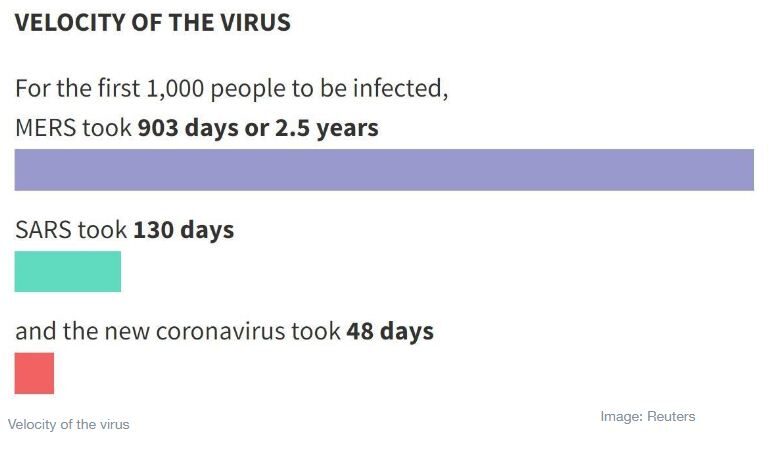
According to WHO and CDC (Centers for Disease Control and Prevention), the term 'coronavirus' is actually an umbrella term one can say so. There are different types of coronavirus, and to be specific, it is seven in number currently, potential to infect human beings. Among these seven, three are evolved from strains of animals. These types of virus attacks cause acute or mild respiratory problem mostly (CleanLink, 2020). The outbreak of SARS (severe acute respiratory syndrome) was first traced back to 2002 in Guangdong, China. This illness spreads through a virus named SARS-CoV.
On the other hand, Middle East respiratory syndrome is a viral respiratory disease detected in the lands of Saudi Arabia in the year 2012. It is better known as MERS-CoV as it is caused by a Middle East respiratory syndrome coronavirus (WHO, 2019).
However, the current virus strain that has taken a toll over our lives and creating a terror of pandemic over the world is a new or novel type of coronavirus. Its nomenclature was done by the International Committee on Taxonomy of Viruses, and the virus was named as SARS-CoV-2 (severe acute respiratory syndrome coronavirus 2). The illness it is spreading is COVID-19. Further explanation of this terminology is CO refers to corona, VI refers o virus, D refers to diseases, and 19 refers to the year 2019.
Therefore, it can be said that all the illness have similar health issue related to severe acute respiratory problem SARS-CoV-2 virus is genetically associated with SARS-CoV. According to a famous epidemiologist named Timothy Sheahan of Gillings School of Global Public Health at the University of North Carolina, 80% of these two different viruses' genomes match. Genetic analysis of SARS-CoV-2 virus has also shown a similar tendency that of SARS-CoV to transmit from one person to another, muted itself to survive or before dying out. It is like Darwinian's theory of evolution, 'survival for the fittest' (NBCNews, 2020).
Symptoms wise, both these two illnesses COVID-19 and SARS are somewhat similar. In both cases, we have seen WHO mentioning first signs of dry coughs, sore throat, fever (sometimes over 100.4°F), short breathing in severe cases, and so on. In case of MERS also, fever, shortness of breath and coughing are some of the common symptoms. Pneumonia and diarrhea are also of the reported symptoms. However, keeping in mind their different genetics structure, there are few differences in the nature of these two different viruses.
For example, as far as MERS is concerned, in most cases, infections are attributed to human-to-human contact. However, recent scientific evidence identify that, dromedary camels are a primary reservoir host for MERS-CoV as well as an animal source of MERS infections in humans. A total of 27 countries including Jordan, Italy, Islamic Republic of Iran, Kuwait, UK, UAE, Kingdom of Saudi Arabia, Austria, Algeria, China, Malaysia, and Lebanon have been affected out of which 80% of the reported human cases have occurred in Saudi Arabia. Out of the affected cases, 35% of the reported cases have ended up as death cases (WHO, 2019).
Transmissibility ratio of COVID-19 (caused by SARS-CoV-2 virus) is higher than SARS (caused by SARS-CoV virus). In the epidemiology of infectious diseases, there is a concept of R0. It refers to the speed of transmitting the disease from a contagious person to others with comparison to its epidemic potentiality. COVID-19’s average R0 is around 3.28, and the median is around 2.79, which is higher than SARS (The Lancet Infectious Disease, 2020). This speed can be estimated from the first incident traced in December 2019 in China, and now in February 2020, there were 80,000 cases. On the contrary, in case of the SARS outbreak from November 2002 to March 2003, only one case of mass contamination was noticed. That was the incident of Diamond Princess Cruise ship, where out of 3,700 on-boards, 700 people were infected.
Do not be shocked to know from the reports of Reuters that, MERS has taken more than 900 days to reach the mark of 1000 people being infected whereas SARS has taken around 130 days. Shockingly but true, COVID-19 has taken less than even 50days to reach the mark. Hence, from the above analysis, it can be said that though there are few similarities in gene-structure and symptoms, these are illnesses and nature of the viruses are different. As long as no vaccination is invented, Staying Home is the only way out to control and slow down the exponential growth of COVID-19.
Reference list
CleanLink (2020). SARS-CoV-2 And COVID-19: What's The Difference?. [Online]. Available at: https://www.cleanlink.com/news/article/SARS-CoV-2-And-COVID-19-Whats-The-Difference--25264
NBCNews (2020). Are coronavirus diseases Equally deadly?. [2020]. Available at: https://www.nbcnews.com/health/health-news/coronavirus-diseases-comparing-covid-19-sars-mers-numbers-n1150321
The Lancet Infectious Disease (2020). Can we contain the COVID-19 outbreak with the same measures as for SARS?. [Online]. Available at: https://www.thelancet.com/journals/laninf/article/PIIS1473-3099(20)30129-8/fulltext
WHO (2019). Middle East respiratory syndrome coronavirus (MERS-CoV). WHO. [Online]. Available at: https://www.who.int/news-room/fact-sheets/detail/middle-east-respiratory-syndrome-coronavirus-(mers-cov)

Comments
There are currently no blog comments.